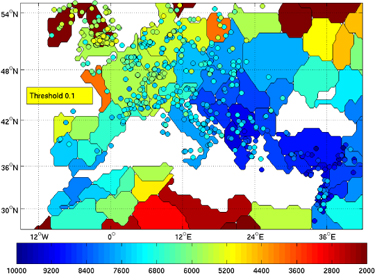|
Global Land Use and Technological Evolution Simulations on New Paleoclimate data: Quantified impact of Holocene climate change on land use, regional agrarianisation and anthropogenic deforestation with feedback
Principal Investigators: Klaus Fraedrich (University of Hamburg), Kai Wirtz (GKSS Geesthacht), Richard Blender (University of Hamburg)
Timing (years before present) of the appearance of agropastoral land use practise in Europe simulated with the Global Land Use and Technological Evolution module (Wirtz _AMP_ Lemmen, 2003). The model results (shading) are compared to the establishment of Neolithic sites according to Turney _AMP_ Brown (2007).
During the Holocene, landscapes were included for the first time into the agrarian system by forest clearance and irrigation, possibly creating the first anthropogenic enhanced greenhouse effect. The two-way interaction of past societies and climate changes will be investigated using a a novel proxy database and coupled global circulation/vegetation simulations. All data sources will be brought into context using a generic mathematical model of technological adaptation to climate change. We consider the global scale from 11600 to at least 3000 BP; our focus is on human nature interaction, adaptation and feedback mechanisms during the 8th millennium BP in Europe and the Asian steppe. The global and long-term assimilation of data from palaeoclimatology and archaeology into a sociotechnological model framework presents a novel and innovative transdisciplinary research which allows for the first time the integration of the anthroposphere into earth system models.
How strong was the influence of climate on the onset of agriculture? Was regionally different climate variability responsible for the observed temporal lag in land use between continents and regions? Did the changed land use intensity lead to changes of local and global climate via a vegetation feedback? These research questions are asked towards the priority program's key question 5: “Which are the mutual impacts between climate and preindustrial cultures?”
Time-series analysis, cluster analysis, coupled climate modelling, dynamic vegetation modelling, aggregate system modelling.
Archives
Archive of long-term, high-resolution climate proxies, Neolithic site databases, radiocarbon database.
|
| < Prev | Next > |
|---|


